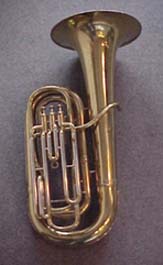ABQtuba wrote:I'm trying out a 3/4 size tuba whose bell engraving announces it to be a York Master. The 3/4 has a serial number 6730xx, which places it outside the range shown in John Swain's York serial number list
It is important to note that York and York Master are not the same thing, and since it isn't actually a York, I'm not surprised that it wasn't on John Swain's list.
I believe Rick Denney has written a lot of the subject, and that the archives contain a lot of information, but I'll tell you that as I recall York Masters were made in the 1960s by Bohm and Meinl (which, I believe had a later connection to Walter Nirschl).
Edit...
Here's some stuff off Rick Denney's site that explains York vs. York Master and gives a pretty solid time frame:
Rick Denney wrote:
York is a legendary name in the tuba world. The main reason is the unique sound they achieve, particularly in the hands of legendary players, such as Arnold Jacobs. His York tuba was made in 1930 for Philip Donatelli of the Philadelphia Orchestra, at the request of Leopold Stokowski. Donatelli found the horn an imperfect ergonomic fit, and sold the horn to his best student, Arnold Jacobs. Jacobs went on the play that instrument throughout his highly illustrious 44-year career with the Chicago Symphony. Two of these instruments were made, and they are now both owned by the CSO.
Even in the 1930's, York was not known for orchestral instruments, but for band instruments. The most well-known tuba player of that era was William Bell, who played a German-style instrument with rotary valves, made by an American company. This design was pioneered by Cerveny, a Bohemian tuba maker, soon after the tuba was invented, and is the direct ancestor of the modern rotary tuba such as the Miraphone. Bell's style was perfect for that sort of instrument: Bright and soloistic with an emphasis on technique. The notion that an orchestral tuba player should build a dark, broad foundation for the ensemble was built by Jacobs. It has been speculated, with a lot of plausibility, that the York was designed to provide a sound similar to that very unorchestral of horns, the sousaphone. Many tuba players now revere the sound of a good sousaphone, but few would dare to use one in an orchestra!
In 1940, the York Band Instrument Company was sold to the Carl Fisher Company, but production on musical instruments ceased during the war so the factory could make munitions. After the war, the factory reportedly made student horns and sousaphones until it was dismantled in 1971.
To keep the reputation of artist-grade Yorks alive, Carl Fisher imported a series of horns under the label York Master that were made in West Germany by Boehm and Meinl. Boehm and Meinl was a maker of good reputation that produced top-line horns for many American importers, including the coveted Marzan CC. The York Master was made in the American style, using designs adapted from the York instruments that had previously been made in the U.S. The York Masters were not nearly as large as the Chicago York, but many report that they had the same characteristic sound and playing qualities. Boehm and Meinl was purchased in 1992 by Walter Nirschl, who continues to produce superb copies of York designs including a popular copy of the Chicago York.


